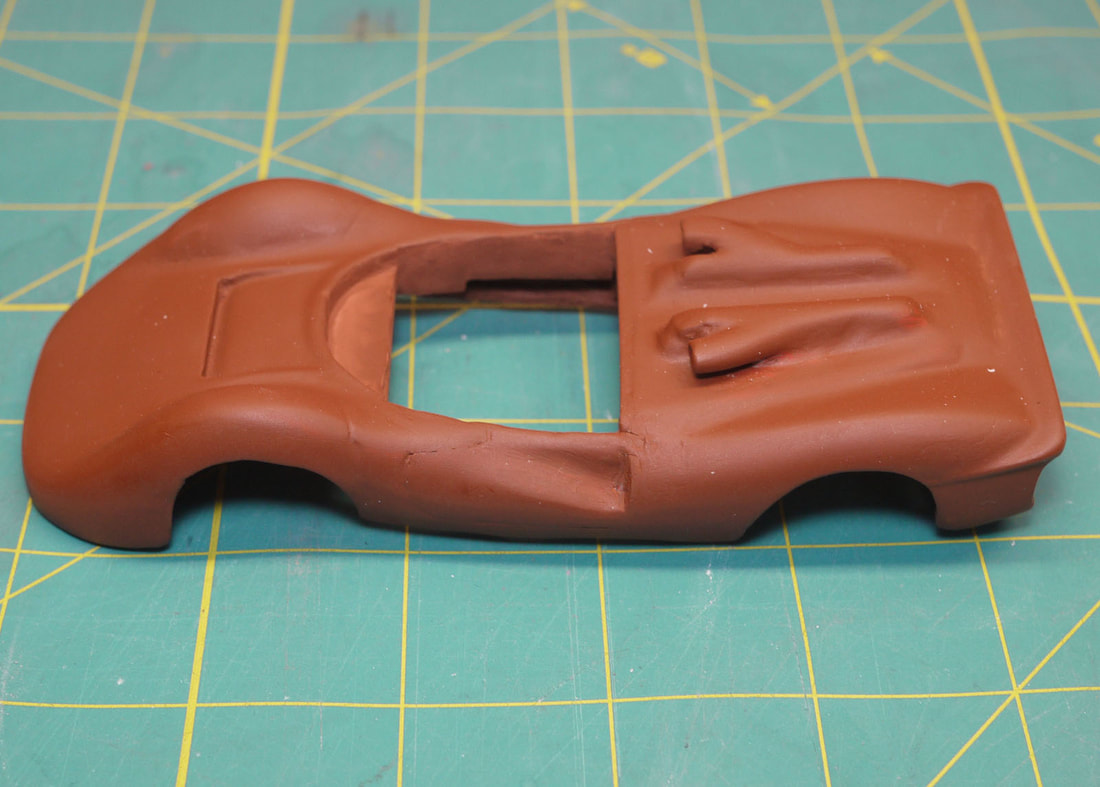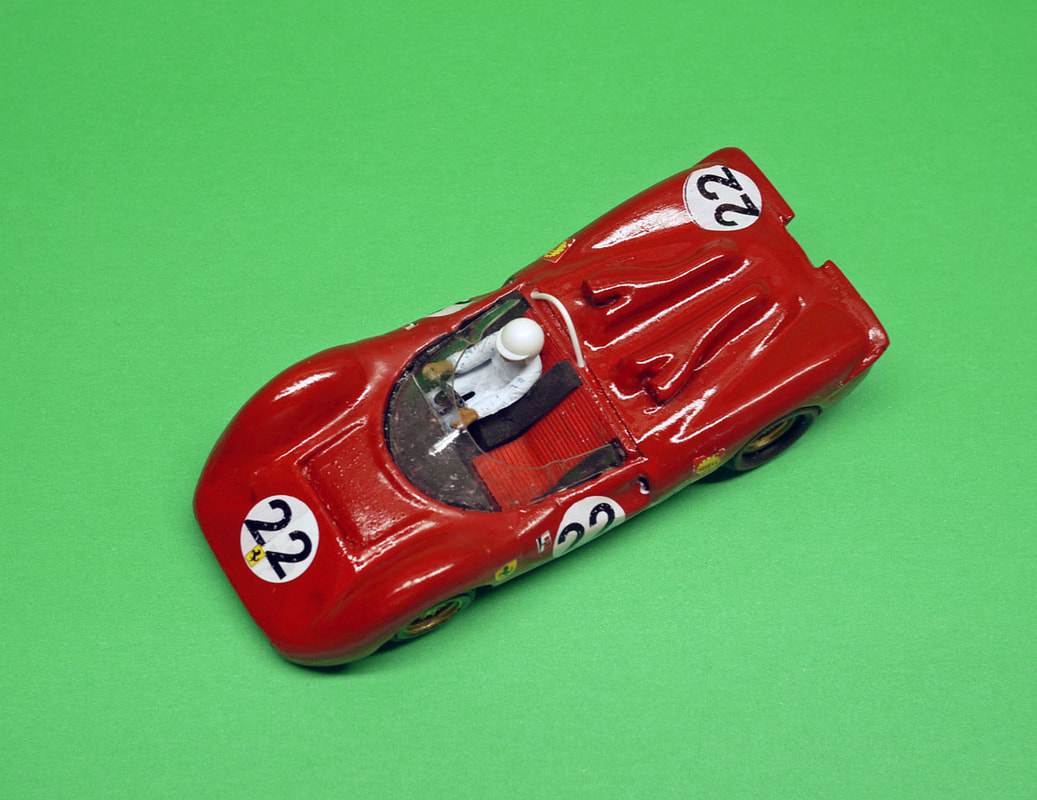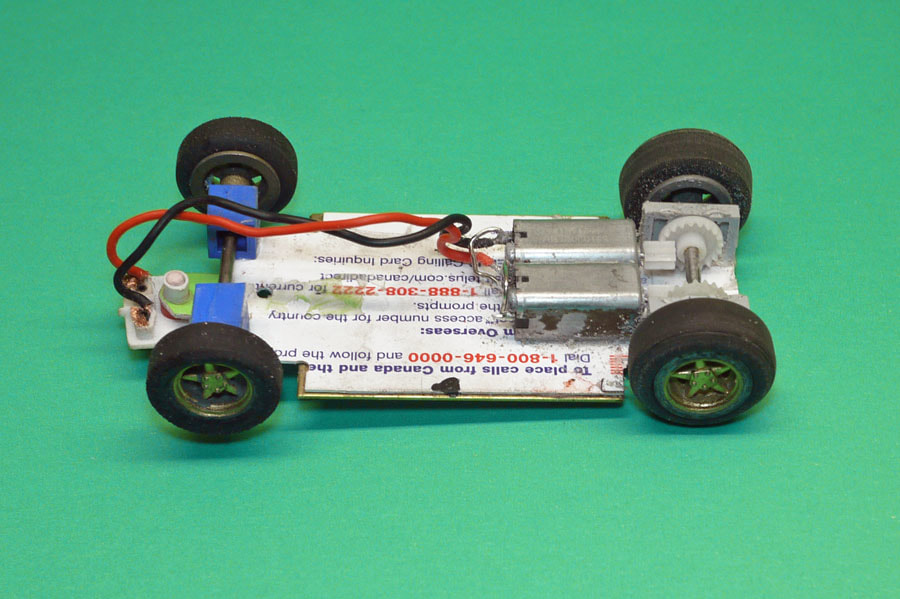Page 1 of 1
Ferrari 350 Can Am

Posted:
Fri Sep 15, 2017 11:50 pmby BARC 1
I spent some time doing up a master of a Ferrari 350. Took some pictures to find flaws before commiting to a mold. This is my second attempt. The first one just didn't look right so I reworked the front end and I am happier with this one.

Here is a picture of the first one. The front end just wasn't long enough and once I had it finished, I decided to redo another master.


Re: Ferrari 350 Can Am

Posted:
Sat Sep 16, 2017 3:23 amby munter
Nice work. I assume this is 1/32 scale?
It is interesting how the camera picks up on things the human eye seems to miss.
Re: Ferrari 350 Can Am

Posted:
Sat Sep 16, 2017 6:24 amby BARC 1
Thanks , and yes this is a 132 version.
A close up photo is your best critic. Things I don't see become obvious in a photo. I think taking pictures has become my best modelling tool.
Re: Ferrari 350 Can Am

Posted:
Sat Sep 16, 2017 7:31 amby chappyman66
Lovely work on a hard to find body. Nicely done. The camera sees all...
Re: Ferrari 350 Can Am

Posted:
Sat Sep 16, 2017 7:32 amby Mitch58
Great job.
Re: Ferrari 350 Can Am

Posted:
Sat Sep 16, 2017 7:34 amby chappy
Very nice Dan
Bob
Re: Ferrari 350 Can Am

Posted:
Sat Sep 16, 2017 10:25 amby BARC 1
Again thanks for the comments
The chassis for this is a Gift Card, Brass and Lego all held together by a generous application of Gorilla Glue CA.
I tried an inline dual motor set up using my standard Minebea S cans. Doubling up the torque for more grunt, but limited by the 16 K RPM for top speed. However as most of my cars are powered by this motor, they all turn competitive times with one another.

Re: Ferrari 350 Can Am

Posted:
Sat Sep 16, 2017 11:43 amby crossovercrazy
Who wants an NSR chassis when you can have a sophisticated one like that (kewl!)
I am going to buy gift cards just to use, unspent, as chassis! That would still be cheaper than many other chassis alternatives! (beware of the popsicle stick rivals)
PM sent
Re: Ferrari 350 Can Am

Posted:
Sat Sep 16, 2017 1:37 pmby munter
Hi again BARC 1....can you tell me about the crownwheel/pinion you have used and what diameter the crownwheel is?
That gear set might be useful for someone building an F1/GP car.
Re: Ferrari 350 Can Am

Posted:
Sat Sep 16, 2017 2:18 pmby BARC 1
It is exactly the gear combo I use for the 60's F1 cars I recently done
I will get the calipers out and measure the diameter and tooth count this evening
Re: Ferrari 350 Can Am

Posted:
Sat Sep 16, 2017 4:18 pmby Wobble
Barc1, from top to bottom this is just the bees knees and I love the twin motor set up. Please tell me, what glue do you use to assemble your chassis components?
Re: Ferrari 350 Can Am

Posted:
Sat Sep 16, 2017 5:09 pmby BARC 1
Munter
Crown gears are 10.8mm with 20 teeth. They have a 2mm bore and I have to drill them out to 2.38mm for 132 cars. For 143 I use 2mm axles so no mod is necessary
Wobble
Gorrilla CA adhesive is my preferred CA. It has been formulated with a good sheer strength and can handle wrecks well. I have yet to have a chassis fail except for a wreck that propelled the car over the catch fence and down 40 inches onto a concrete floor. It was back in action in minutes.
I have one chassis running in the Pan American Proxy. It is a mid packer, running a Jack Rabbit motor and is still going with a couple of races yet to go.
I have another one running in the Trans Am proxy, but it is way underpowered running the small Mineabea S can motor, so is sitting in last place I think. No fault of the chassis though, just needs more grunt. This is why I started playing around twining up the motors. Two of them together are just short of a 100g/cm torque, but they only turn 15-16 K at 12 volts. If they get stuck on a track at 10 volts they are really slow. At home I run them at 14 volts, and at 14 volts they perform well, but I have discovered most proxies are run at 12 volts or less, so these little S cans don't do so well. They need 14 volts to come alive.






